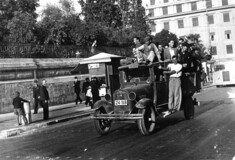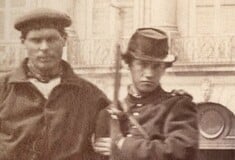
Φωτ. Zena's pictures.
Η επιδημία νευρικού γέλιου στην Tanganyika το 1962 υπήρξε ένα φαινόμενο μαζικής υστερίας. Η επιδημία γέλιου ξεκίνησε στις 30 Ιανουαρίου του 1962 από ένα οικοτροφείο θηλέων στο χωριό Kashasha. Το νευρικό γέλιο τριών αρχικά κοριτσιών, εξαπλώθηκε στο υπόλοιπο σχολείο, επηρρεάζοντας 95 από τις 159 μαθήτριες, όλες μεταξύ 12 και 18 ετών. Τα συμπτώματα κράτησαν συνήθως μερικές ώρες, άλλα κάποια κορίτσια υπέφεραν απ' αυτά μέχρι και 16 μέρες. Το εκπαιδευτικό προσωπικό, το οποίο έμεινε ... αλώβητο, ανέφερε πως οι μαθήτριες ήταν ανίκανες να συγκεντρωθούν. Το σχολείο έκλεισε αναγκαστικά στις 18 Μαρτίου του 1962. Μετά το κλεσιμό του και την επιστροφή των μαθητριών στα σπίτια τους, η επιδημία έφτασε μέχρι το χωριό Nshamba, απ' όπου κατάγονταν μερικές μαθήτριες που είχαν κρίσεις νευρικού γέλιου. Τον Απρίλη και τον Μάη, 217 κάτοικοι του χωριού εμφάνισαν παρόμοιες κρίσεις, στην πλειοψηφία τους παιδιά που πήγαιναν σχολείο ή νεαροί ενήλικες. Το σχολείο της Kashasha άνοιξε πάλι στις 21 Μαίου, αλλά χρειάστηκε να ξανακλείσει προς το τέλος του Ιουνίου. Τον Ιούνιο, η επιδημία νευρικού γέλιου εξαπλώθηκε μέχρι το δημοτικό σχολείο θηλέων του χωριού Ramashenye, κοντά στο Bukoba, πλήττοντας 48 κορίτσια. 'Επειτα, ένα νέο κύμα εκδηλώθηκε στο Kanyangereka, όπου και έκλεισαν δύο σχολεία αρρένων. Έξι έως δεκαοκτώ μήνες αφότου εκδηλώθηκε, το φαινόμενο εξαφανίστηκε. Εκτός από το νευρικό γέλιο, τα συμπτώματα που παρατηρήθηκαν κατά τη διαρκειά του, ήταν : πόνος, λιποθυμία, αναπνευστικά προβλήματα, εξανθήματα, σπαρακτικό κλάμα, και ουρλιαχτά. Συνολικά, 14 σχολεία έκλεισαν και 1000 άτομα επλήγησαν. (Βλ. Wikipedia).

Rubya Primary School, κοντά στο χωριό Kashasha. Βλ. Panoramio.

Βλ. Sometimes Interesting.
The Tanzanian Laughter Epidemic (Laughology).

Dar-es-Salaam, East Africa 1958-62, Tanzania - Tanganyika trip. Το οικογενειακό άλμπουμ του Martin W. Dixon.

Uluguru Mountains, φυτείες σιζάλ. Φωτ. Martin W. Dixon.

'Αφιξη με Dakota στο αεροδρόμιο της Ζανζιβάρης. Η Τανζανία προέκυψε από την Ένωση το 1964 της Τανγκανίκας με τη Ζανζιβάρη. Φωτ. Martin W. Dixon.

Θέα από το παράθυρο του ξενοδοχείου. Φωτ. Martin W. Dixon.

Hotel Same. Φωτ. Martin W. Dixon.

Turiani Shell station. Φωτ. Martin W. Dixon.

Mosque, Moshi. Φωτ. Martin W. Dixon.

Harem, Sultan's palace, Zanzibar. Φωτ. Martin W. Dixon.

Zanzibar. Φωτ. Martin W. Dixon.

Zanzibar - Making copra. Φωτ. Martin W. Dixon.

Φυλακή των σκλάβων, Zanzibar. Φωτ. Martin W. Dixon.

Παιδιά της φυλής Masai με τα γλυφιτζούρια τους. Φωτ. Martin W. Dixon.

Βλ. Old Print.
Dancing Mania στο Μεσαίωνα !
(από το μπλογκ Sometimes Interesting).
In July of 1518 in Strasbourg, France, a woman named Frau Troffea walked into the street and started to dance. She continued to dance on the street for several days, and by the end of the week 34 others had joined her. By the end of the month there were around 400 dancers in the streets. These people danced uncontrollably and in bizarre fashion; shouts, screams, and singing were reported to accompany hallucinations. Eventually, many would die from heart attack, stroke, or exhaustion.

Dance mania victims, in a painting by Pieter Breughel the Younger after drawings by his father. The musicians are playing Flemmish bagpipes known as doedelzaks. Βλ. One Hand On The Radio.
As the number of participating dancers grew, local officials started to worry. For some reason, physicians of the day encouraged more dancing, incorrectly assuming that the afflicted would only heal if they danced continuously night and day. Dance halls were constructed and musicians were paid to play music to keep the afflicted moving. This strategy backfired and if anything encouraged more people to dance.
Dancing mania, also sometimes known as St. Vitus ' dance, was first recorded in the 7th century and reappeared many times across Europe until about the 17th century. The Strasbourg incident in 1518 is by far the most well-known, although numerous other "outbreaks" – namely the 1374 outbreak in Aachen Germany – are very familiar to historians as the events were well recorded.
Several theories are suggested as to what caused the dancing mania. Mass Psychogenic Illness (MPI), a type of mass hysteria preceded by episodes of distress, is thought to have possibly been a cause due to high levels of poverty and famine at the time. Yet another theory is the afflicted succumbed to ergotism, which resulted from consuming ergot (a mold) on tainted bread. Consuming ergot has been known to cause seizures, delirium, and hallucinations – although it is also known to restrict blood flow to the limbs, which would make it rather hard to dance.

Still, others point to religion or superstition. Saint Vitus' dance was the term most often assigned to dancing manias of medieval times; Catholic legend says invoking the wrath of Saint Vitus would provoke compulsive dancing. This might just be the most plausible explanation since the dancing plague appeared to die out as the supernaturalist beliefs that fed it gradually disappeared. This theory holds water in that as Protestantism spread through the area, the disease eventually disappeared. The theory goes that Protestants spurned the saint worship on which stories of the dancing plague depended, thus removing the superstition. By the mid-17th century, there were no more cases of the dancing plague recorded.
Amidst the tragedy of people losing their lives to such a plague, one has to marvel at the unsophisticated approach that we, as humans, had toward illnesses back in medieval times . They're called the Dark Ages for a reason, right? I guess what I want to know is, did the dancers at least have rhythm?

Engraving of Hendrik Hondius (1642) portrays women affected by the plague. Work based on drawing by Pieter Brueghel the Elder, who witnessed an outbreak in 1564 in Flanders. Βλ. One Hand On The Radio.






























σχόλια